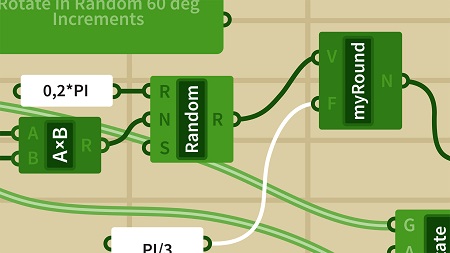
English | MP4 | AVC 1280×720 | AAC 48KHz 2ch | 6h 24m | 1.18 GB
Algorithmic modeling is where design and programming intersect. Grasshopper—a plugin for Rhino 3D—is a graphical algorithm editor that allows you to create complex 3D models with less grunt work. The resulting designs are both sophisticated and flexible. In this course, artist and programmer Chris Reilly introduces advanced math techniques and fully-developed hands-on projects that help you understand how to make the most out of the parametric design tools in Grasshopper. See how to build a flexible product design for mass production with a parametric design algorithm. Plus, learn how to use plugins like Ladybug to model big data sets, generate recursive patterns with scripting, and build geometric patterns that auto-tessellate.
By the end of the course, you’ll see how even basic literacy in Grasshopper can be applied to developing projects for art, manufacturing, architecture, and design.
Topics include:
- Working with algorithms
- Modeling a base profile
- Extruding elements
- Finishing an algorithm
- Planning for mass production
- Customizing Grasshopper
- Scripting with Python and Visual Basic .NET
- Modeling data with Ladybug
- Creating a tiling grid
- Tiling 3D objects
- Using reflection symmetry and mirroring to repeat tile
- Tessellating tile in any direction
Table of Contents
1 Welcome
2 What you should know
3 What’s new in Rhino 6
4 Using the exercise files
5 Introduction to associative design
6 Working with algorithms
7 Iteration and recursion
8 Introduction and file setup
9 Modeling the base profile
10 Modeling the through hole profiles
11 Modeling the top profile
12 Modeling the fret track profiles
13 Extruding the frets
14 Extruding the solid base
15 Extruding the solid top
16 Finishing the algorithm
17 Planning for mass production
18 Estimating materials for mass production
19 Clusters
20 Custom components with user objects
21 Add-ons and plugins
22 Python scripting
23 Visual Basic .NET scripting
24 Vector review
25 Intro to Ladybug plugin
26 Installing the Ladybug plugin
27 Importing weather data with Ladybug
28 Analyzing wind data with Ladybug
29 Displaying Ladybug wind data with vectors
30 Visualizing wind data over time with Ladybug
31 Sunlight simulation with Ladybug
32 Calculating average sun vectors in Ladybug
33 Optimizing solar panels with Ladybug and vector cross product
34 Shadow study with Ladybug
35 Surface analysis with vector dot product
36 Aligning shapes to vectors
37 Data tree review
38 Hexagonal tiling introduction
39 Setting up a hexagonal tiling grid
40 Finishing a hexagonal tiling grid
41 Adding offsets for tiling
42 Adding additional tiling parameters
43 Planning for tiling 3D objects
44 Tiling 3D objects
45 Truchet tile fundamentals
46 Planning a parametric hexagonal tile
47 Creating a parametric hexagonal tile
48 Planning a parametric truchet tile
49 Creating a parametric truchet tile
50 What is Kangaroo
51 Installing Kangaroo
52 Where to get help with Kangaroo
53 Exploring Kangaroo basics
54 Multi-goal simulations
55 Simulating basic tensile structures
56 Simulating tensile meshes
57 What are grid shells
58 Simulating grid shells
59 Flexible anchor points
60 Measuring tolerances
61 Form-finding with Kangaroo
62 Fine-tuning a physics simulation
63 Next steps
Resolve the captcha to access the links!